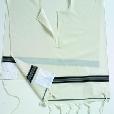Rabbi Shlomo Riskin of Efrat offered an interesting interpretation of the word “tzitzit” in his article on Parshat Tetzaveh this week.
“What is most jarring to the modern ear,” Rabbi Riskin notes, “is the painstaking description of the eight special garments of the High Priest and the four special garments of the regular priests.
Clothes Make the Man?
“The Talmud stipulates that only when properly garbed [Exodus 28:2] are the priests endowed with sanctity and permitted to minister in the Sanctuary [B.T. Zevahim 7]. Is the Torah then teaching us that ‘clothes make the man?’
“The priestly garb is not meant to endow sanctity but to inspire it, as well as to instill within the priests the confidence that they can make the entire world sacred. Moreover, the Torah teaches that every Jew must see him/herself as a High Priest dressed in sacred vestments, a member of ‘a holy nation and a Kingdom of priests.'”
Rabbi Riskin explains that the High Priest must always wear the tzitz, a gold headband on a heavenly blue thread of techelet, upon which it is written “holy unto the Lord.”
Tzitzit: Mini Tzitz
 He then writes that the traditional Jewish men’s garb is the tallit, or the smaller tallit katan (ideally with a thread of blue techelet, the salient feature of the High Priest’s tzitz), noting that the tassels are called tzitzit, or “a junior tzitz.”
He then writes that the traditional Jewish men’s garb is the tallit, or the smaller tallit katan (ideally with a thread of blue techelet, the salient feature of the High Priest’s tzitz), noting that the tassels are called tzitzit, or “a junior tzitz.”
Rabbi Riskin concludes by saying that to inspire himself to share in the mission to perfect the world every Jew must wear “the priestly, regal garments, which teach commitment to God and commitment to the nation.”
